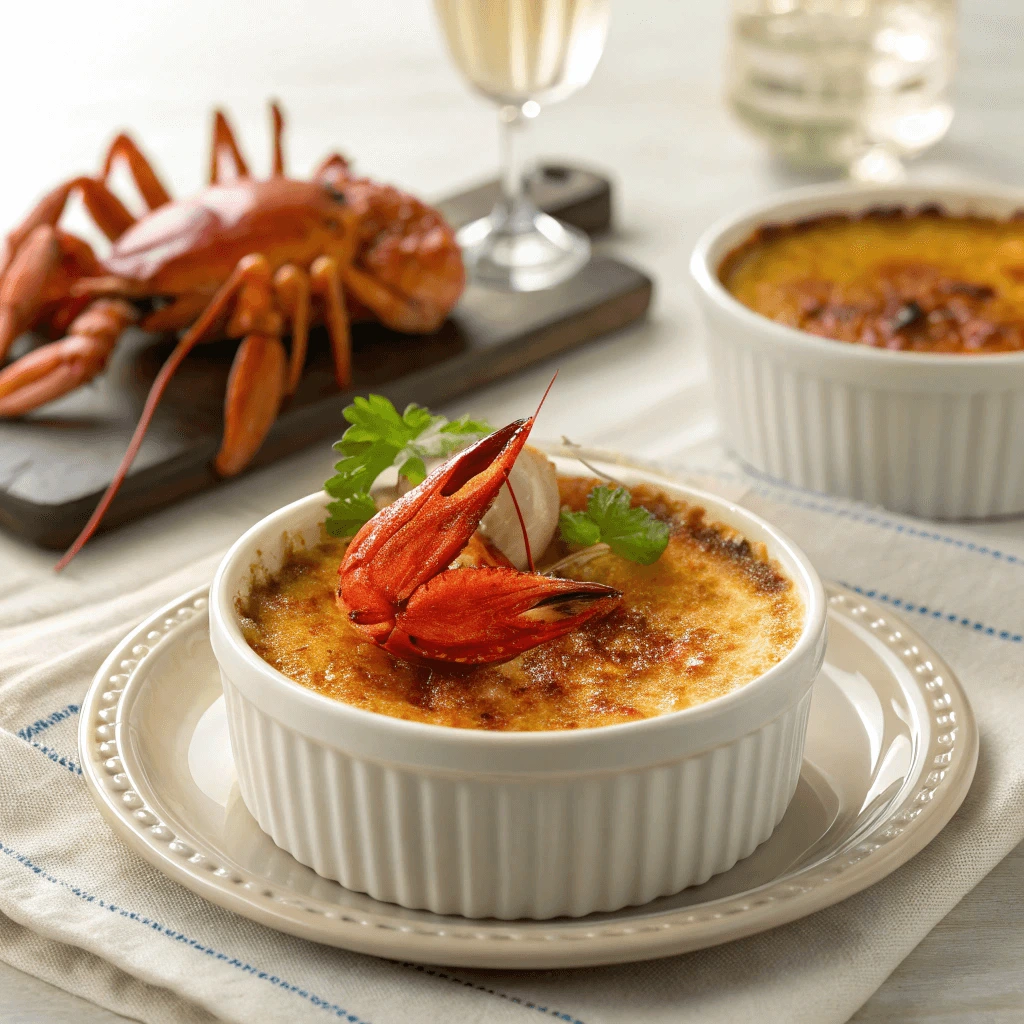If you love seafood and enjoy elegant appetizers, you’ll want to try crab brulee. This savory twist on classic crème brûlée blends rich crab meat, creamy custard, and a caramelized topping into one impressive dish. You can easily prepare it at home with a few fresh ingredients and the right technique. Whether you’re planning a romantic dinner or hosting a special gathering, this step-by-step recipe will guide you through making the perfect crab brulee—from selecting quality ingredients to finishing it off with a crisp, golden crust.
What Is Crab Brulee?
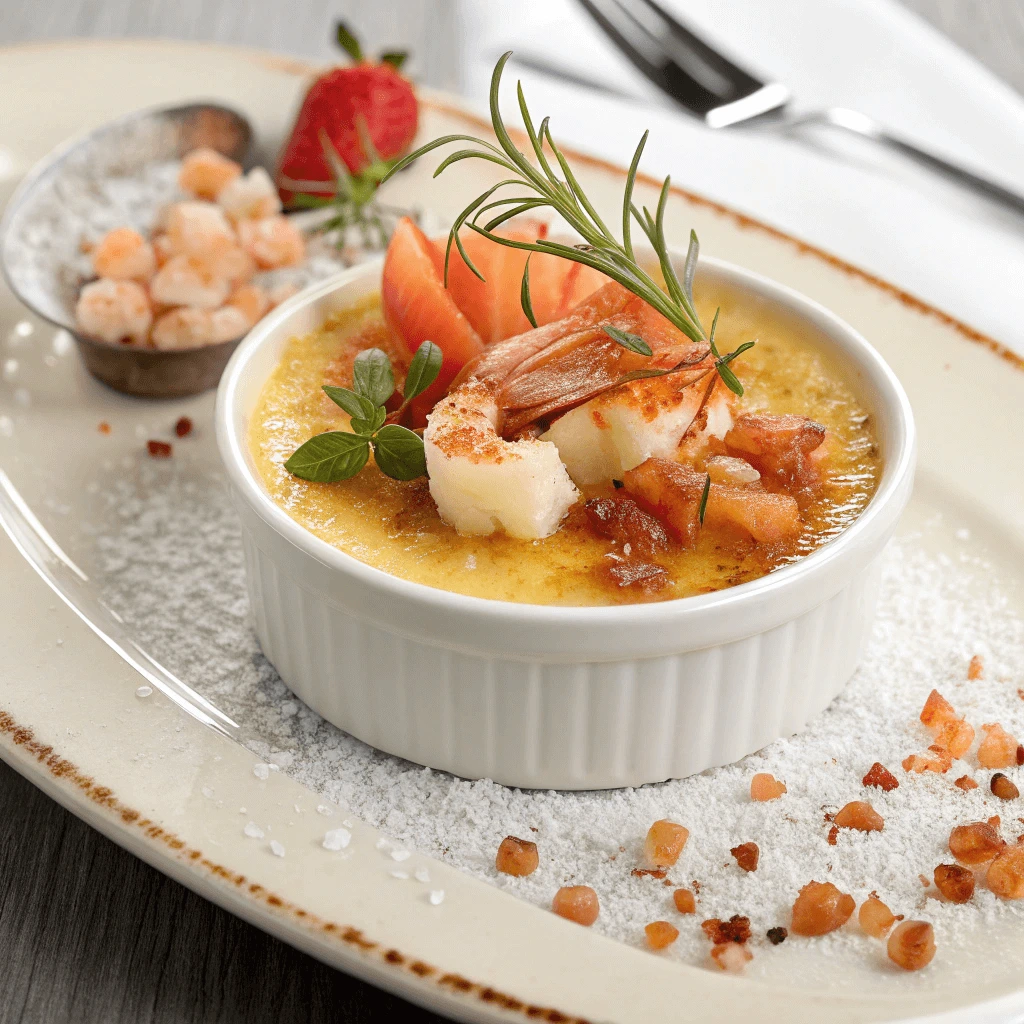
A Savory Take on Classic Crème Brûlée
When most people hear “crème brûlée,” they picture a sweet dessert with vanilla custard and a crisp caramelized sugar topping. But this beloved French dish also has a savory side that deserves attention—especially when paired with something as flavorful as crab. Savory brûlées swap out the sugar and vanilla for rich ingredients like seafood, cheese, and herbs, making them perfect as an appetizer or an elegant starter.
Turning Sweet into Savory
Instead of using sugar and cream, savory versions focus on balancing creamy textures with bold flavors. In crab brûlée, chefs blend lump crab meat with egg yolks, cream, and cheese to create a silky custard packed with umami. A light bruleed topping adds texture and contrast without overwhelming the delicate crab flavor.
Why It Works with Crab
Crab pairs naturally with creamy and buttery components, which makes it an ideal candidate for a brûlée base. The custard enhances the sweetness of the crab, while ingredients like Parmesan, shallots, or chives add depth. A crisp top layer made with a fine sprinkle of cheese or breadcrumbs—not sugar—creates that signature brûlée crunch in a savory way.
A Modern Twist on a Classic
Chefs in upscale restaurants have already embraced savory crème brûlée as a way to surprise and impress guests. Now, home cooks are starting to experiment too. By using fresh seafood and high-quality ingredients, you can serve a dish that feels both familiar and inventive—perfect for holidays, dinner parties, or date nights at home.
Why Crab Brulee Is Perfect for Seafood Lovers
Crab brulee combines the best of both worlds: the sweet, delicate flavor of crab and the rich, creamy texture of a brûlée custard. This dish is a perfect choice for seafood lovers looking for something both elegant and unique.
A Sweet and Savory Combo
Crab’s natural sweetness shines through in the custard, while the creamy texture adds richness without overpowering the crab’s delicate flavor. This creates a balanced and indulgent experience that will satisfy any seafood enthusiast.
A Sophisticated Seafood Appetizer
Crab brulee offers a refined presentation that makes it ideal for dinner parties or special occasions. The crispy, caramelized top contrasts beautifully with the creamy interior, turning it into a standout dish at any gathering.
Versatile and Flavorful
The mild flavor of crab pairs perfectly with herbs like chives or Parmesan cheese, giving you the flexibility to customize the recipe. Whether using fresh or canned crab, this dish offers a luxurious way to enjoy seafood in a new form.
When and Where to Serve It
Crab brulee is a versatile dish perfect for various occasions. Its elegant presentation and rich flavors make it a standout choice for both casual and formal settings.
Ideal for Special Occasions
Crab brulee is perfect for celebrations like holidays, anniversaries, or romantic dinners. Its luxurious flavors set the tone for a memorable meal, making it an ideal appetizer for festive occasions.
A Showstopper at Dinner Parties
If you’re hosting a dinner party, serve crab brulee as a unique starter. Its balance of richness and delicacy pairs well with a variety of main dishes, ensuring it pleases guests and complements your menu.
A Luxurious Touch for Holiday Feasts
Add a touch of elegance to your holiday spread with crab brulee. Whether it’s for Thanksgiving, or Easter, it makes a creative and indulgent appetizer that stands out at festive gatherings.
Key Ingredients and Tools You’ll Need
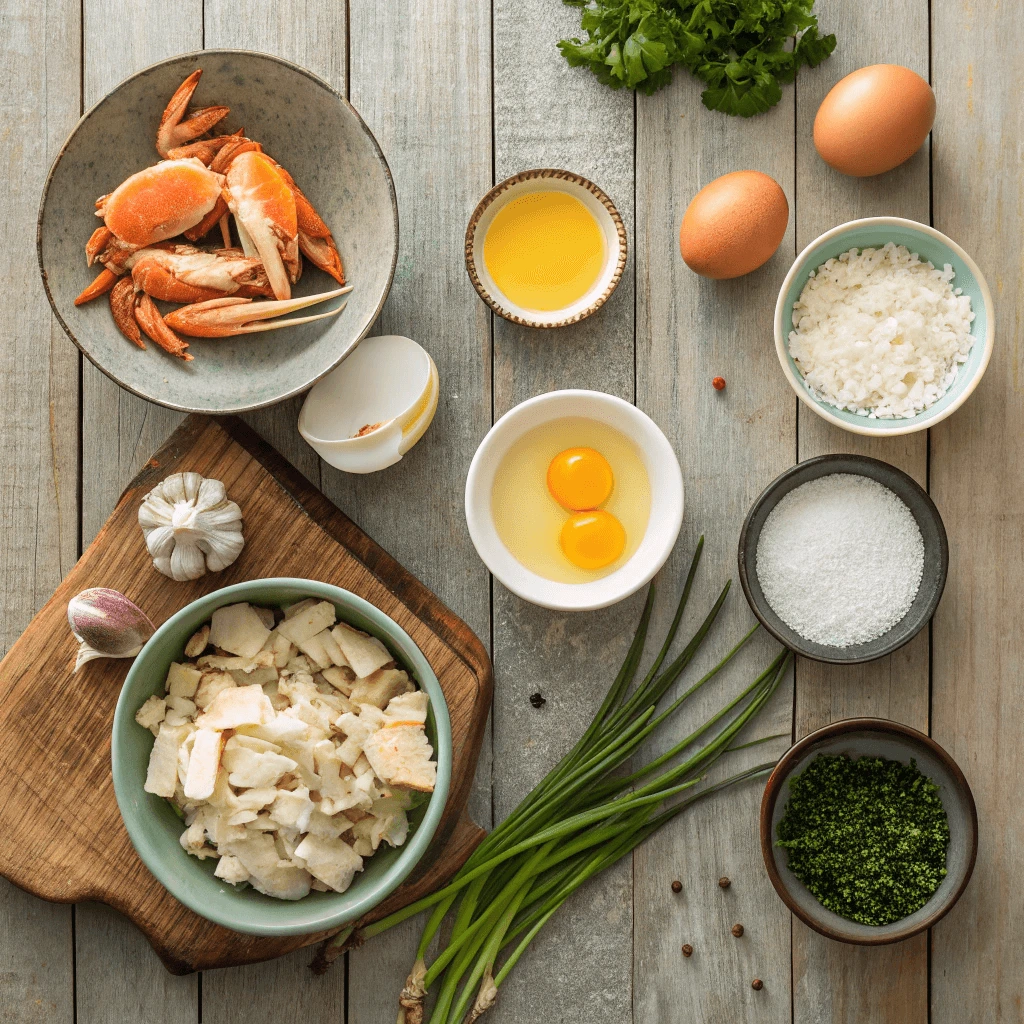
Choosing the Right Crab Meat for How to Make the Perfect Crab Brulee
Choosing the right crab meat is key to making a perfect crab brulee. Here’s a quick guide to the best options for your dish.
Jumbo Lump Crab Meat
Jumbo lump crab meat offers the largest, sweetest pieces of crab. It’s perfect for a luxurious, flavorful crab brulee. The large chunks provide a satisfying texture that pairs beautifully with the creamy custard.
Lump Crab Meat
Lump crab meat is a great middle ground. It has a firm texture and a slightly sweet flavor, making it ideal for crab brulee. It’s also more affordable than jumbo lump, offering great value without compromising on quality.
Backfin Crab Meat
Backfin crab meat is a blend of smaller pieces and is a cost-effective choice. It has a mild sweetness and works well in crab brulee, especially if you want to stretch your ingredients without sacrificing flavor.
Canned or Frozen Crab Meat
High-quality canned or frozen crab meat can be a good alternative when fresh crab isn’t available. Look for minimally processed options and be sure to drain the meat thoroughly before using it in your brulee.
Essential Ingredients: Egg Yolks, Heavy Cream, and More for the Perfect Crab Brulee
The perfect crab brulee relies on a rich custard base made from cream, egg yolks, cheese, and subtle flavor enhancers. Each ingredient plays a key role in achieving the right texture and depth of flavor.
Cream: Rich and Smooth
Heavy cream creates the silky, smooth texture of the custard. It adds richness and binds the ingredients together for a creamy base. Using fresh, high-quality cream enhances the flavor and texture, giving the dish a luxurious finish.
Egg Yolks: For Thickness and Flavor
Egg yolks provide structure and richness, helping the custard thicken and set. They contribute a golden color and add depth to the flavor, complementing the crab without overpowering it.
Cheese: A Touch of Savory
A small amount of grated Parmesan or another hard cheese can elevate the brulee. Cheese adds a savory depth and helps create a crispy, golden top. Be careful to use it sparingly to keep the crab’s natural sweetness the star of the dish.
Flavor Enhancers: Balancing the Richness
Flavor enhancers like black pepper, herbs, and a touch of lemon zest can brighten the dish. Fresh pepper adds warmth, herbs bring subtle notes, and lemon zest offers a refreshing lift that balances the richness of the custard.
Tools You’ll Need: Ramekins, Kitchen Torch, and More for How to Make the Perfect Crab Brulee
To create the perfect crab brulee, you need the right kitchen tools. These essentials will help you achieve even cooking, smooth custard, and a beautiful caramelized top.
Ramekins: Even Cooking
Ramekins are crucial for portioning and cooking the crab brulee evenly. Their small size ensures consistent heat distribution, which is key for getting that smooth, creamy texture. Aim for ramekins that hold 6 to 8 ounces, perfect for individual servings.
Kitchen Torch: Caramelizing the Top
A kitchen torch is essential for achieving the signature caramelized crust. It allows for precise control, ensuring an even, golden-brown finish. A high-quality torch ensures reliable results without the risk of burning.
Mixing Bowls and Whisk: Smooth Custard
Use mixing bowls to whisk together the custard ingredients. A balloon whisk helps you blend the cream, egg yolks, and cheese into a smooth mixture. Choose bowls that are sturdy enough to handle the mixture without spilling.
Baking Sheet: Stability
A baking sheet provides stability when baking the ramekins in the oven. It prevents tipping and catches any drips, making cleanup easier.
Strainer: For a Smooth Finish
Strain the custard mixture to remove any lumps and ensure a smooth texture. A fine mesh strainer or sieve is perfect for this step, ensuring your brulee has a flawless custard base.
Step-by-Step Instructions for Making Crab Brulee
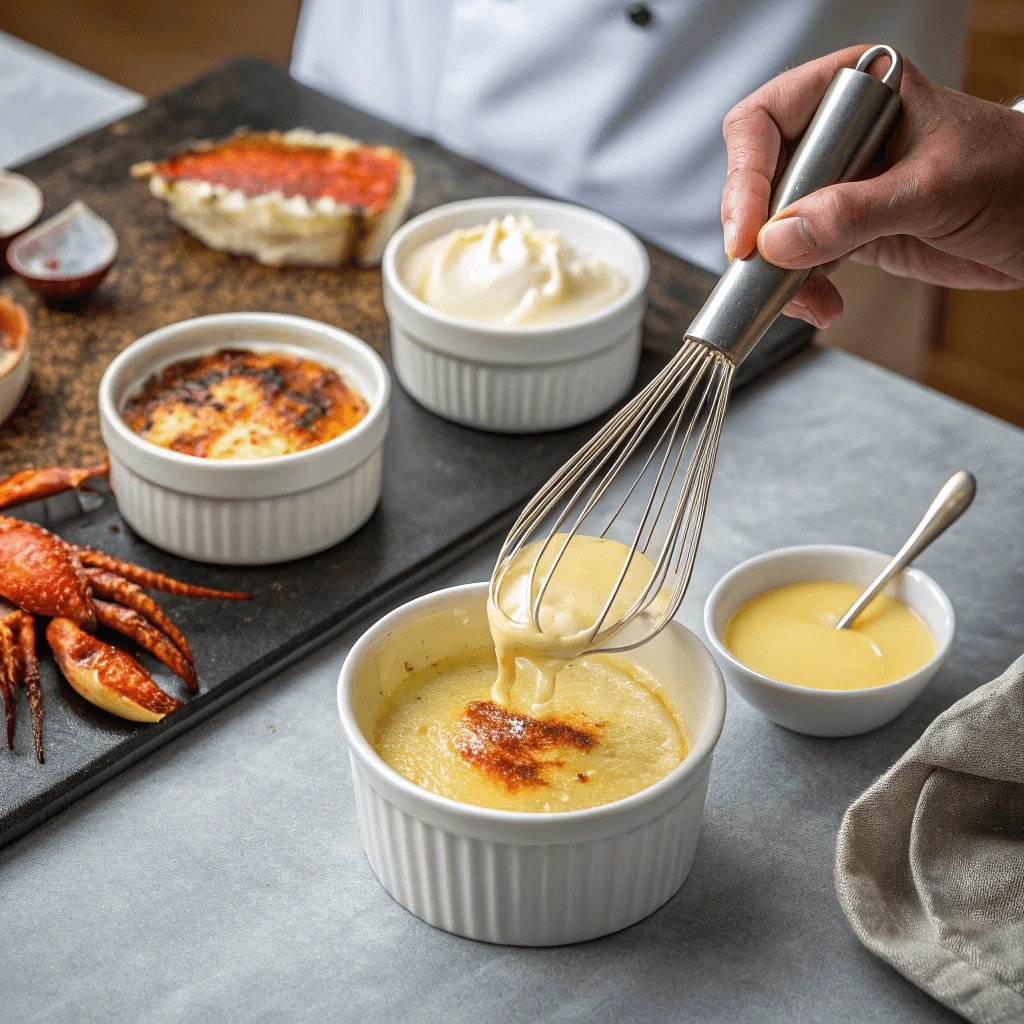
Making the Custard Base
The custard base is the heart of crab brulee. It provides the creamy texture and rich flavor that make this dish stand out. To get it right, you need to focus on balancing richness with lightness, while infusing subtle layers of savory taste.
Combine Cream and Aromatics
Start by gently warming your heavy cream in a saucepan over medium heat. Add aromatics like bay leaf, a sprig of thyme, or a pinch of nutmeg to infuse the cream with flavor. Stir occasionally and avoid letting it boil—just heat it enough to draw out the flavors. Once warm, remove the aromatics to keep the texture smooth.
Whisk Egg Yolks and Cheese
In a separate bowl, whisk the egg yolks until they become light and slightly frothy. Add grated Parmesan or another hard cheese to introduce depth and a savory kick. The cheese not only enriches the flavor but also contributes to the brulee’s creamy texture.
Temper the Eggs
Slowly pour the warm cream into the egg and cheese mixture while whisking continuously. This step, called tempering, prevents the eggs from curdling. Pour in the cream gradually and keep the whisk moving to ensure a smooth blend.
Strain for a Silky Texture
After combining, pour the custard mixture through a fine mesh strainer. This step removes any clumps or cooked egg bits, ensuring the final custard is silky and lump-free. Once strained, your custard base is ready to be poured into ramekins for baking.
Baking the Crab Brulee
Baking is the step that transforms your custard mixture into a velvety, savory masterpiece. To achieve the ideal texture—creamy and just set—you need to use gentle heat and even baking.
Preheat and Prepare
Start by preheating your oven to 300°F (150°C). This low temperature ensures the custard bakes slowly and evenly, preventing it from curdling or cracking. Arrange your ramekins in a deep baking dish or roasting pan, leaving space between them.
Add the Water Bath
To protect the delicate custard, create a water bath (also known as a bain-marie). Carefully pour hot water into the baking dish until it reaches halfway up the sides of the ramekins. The water surrounds the ramekins with gentle heat, allowing the custard to set without becoming rubbery.
Bake Until Just Set
Place the baking dish on the center rack of the oven. Bake the crab brulee for 30 to 40 minutes, depending on the size of your ramekins. Check for doneness by gently shaking one ramekin—the custard should jiggle slightly in the center but feel firm around the edges. Avoid overbaking, as it can lead to a grainy texture.
Cool and Chill
Once baked, carefully remove the ramekins from the water bath using tongs or a thick towel. Let them cool at room temperature for 20 to 30 minutes. Then, transfer them to the refrigerator to chill for at least two hours. Chilling helps the custard firm up and enhances the overall flavor.
Caramelizing the Brulee Top
The caramelized crust is what gives crab brulee its signature look and irresistible contrast in texture. Achieving that perfect, golden top layer requires careful technique and the right tools.
Add the Sugar Layer
After chilling the baked custards thoroughly, remove the ramekins from the refrigerator. Gently blot the tops with a paper towel if any moisture remains. Sprinkle a thin, even layer of sugar over each custard—about 1 to 2 teaspoons. For a savory crab brulee, you can use plain granulated sugar or mix it with a touch of smoked paprika or cayenne for a spicy-sweet finish.
Torch to Perfection
Hold a kitchen torch a few inches above the sugar layer and move it in small, circular motions. Keep the flame moving constantly to avoid burning one spot. The sugar will melt, bubble, and then harden into a crisp, golden shell. Aim for an amber color—too pale and it won’t be crunchy; too dark and it may taste bitter.
Let the Top Set
Once the sugar has caramelized, give it a minute or two to harden. You’ll know it’s ready when you tap the top lightly with a spoon and hear a distinct crack. This final step adds not just texture, but also visual appeal and that iconic brulee experience.
Pro Tips for the Best Crab Brulee
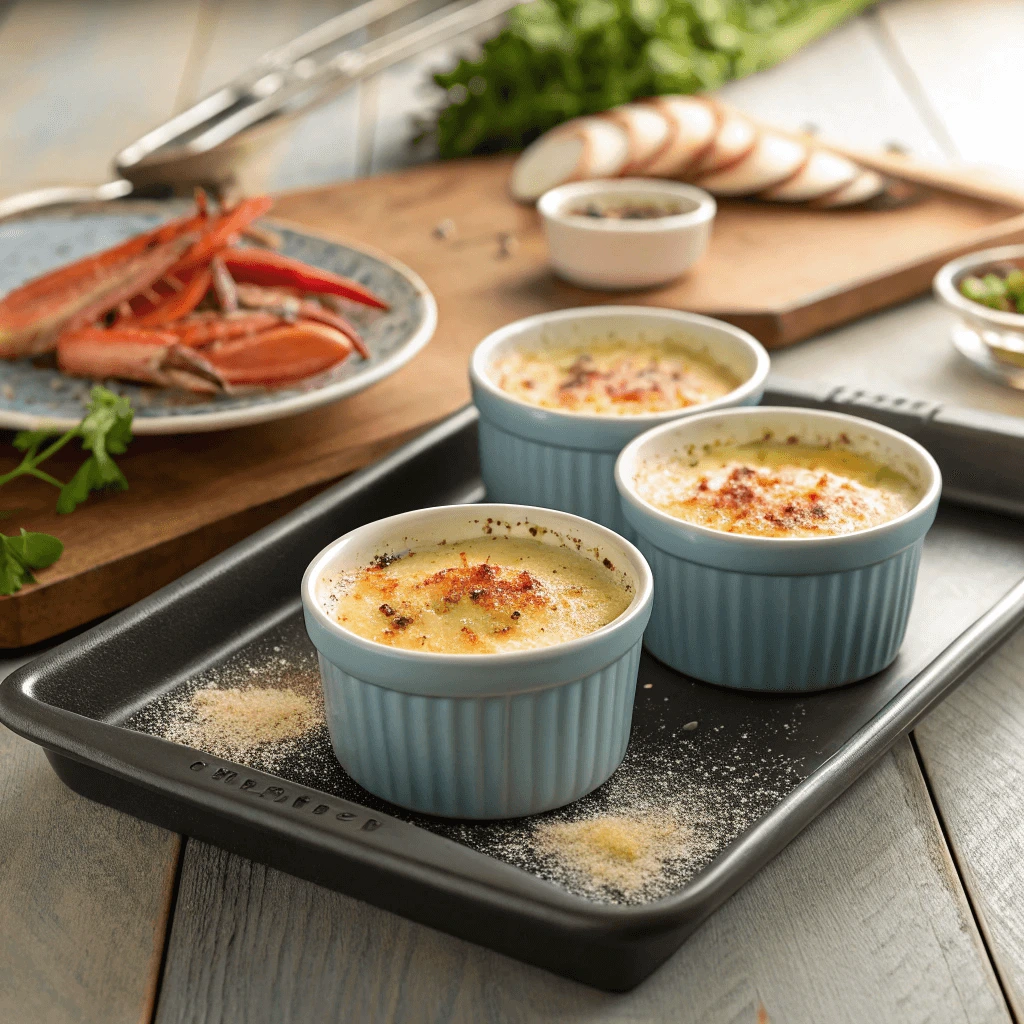
Avoiding a Watery Texture
A smooth, creamy texture defines a perfect crab brulee. A watery or separated custard can ruin the experience, but you can prevent it by following a few key techniques during preparation and baking.
Use the Right Crab Meat
Start with high-quality crab meat that’s well-drained. If you use canned or pre-cooked crab, squeeze out excess moisture with a paper towel or fine mesh strainer. Wet crab meat can release water during baking and affect the custard’s consistency.
Don’t Overmix the Custard
When mixing cream, egg yolks, and cheese, whisk gently until the ingredients just combine. Overmixing incorporates too much air, which can cause the custard to bubble or bake unevenly. These bubbles often lead to a loose or unstable texture.
Bake Slowly and Evenly
Always bake the custard in a water bath to apply gentle, even heat. Avoid rushing the process with high oven temperatures. Fast baking causes the proteins in the eggs to curdle, separating the custard and creating a watery layer. Keep your oven around 300°F (150°C) for the best results.
Chill Thoroughly
After baking, allow the brulee to cool at room temperature, then refrigerate for at least two hours. Chilling helps the custard firm up fully and lets any residual moisture settle. Skipping this step may leave the texture soft or slightly runny.
Achieving the Perfect Brulee Crust
A golden, crisp brulee crust adds the signature crunch that contrasts beautifully with the creamy crab custard beneath. Getting it right involves the right ingredients, tools, and timing.
Choose the Right Sugar
Use fine granulated sugar for the most even caramelization. Its small crystals melt more smoothly and quickly than coarse sugar. If you want to add a savory twist, blend in a pinch of sea salt, smoked paprika, or cracked black pepper for a unique flavor profile that complements the crab.
Apply a Thin, Even Layer
After chilling your custards, pat the tops dry gently with a paper towel. Then, sprinkle a thin and even layer of sugar—about 1 to 2 teaspoons per ramekin. Tilt and rotate the ramekin to distribute the sugar without clumps, ensuring a uniform crust.
Use a Kitchen Torch for Precision
A culinary torch gives you the most control. Hold it a few inches from the sugar and move it in small, circular motions. Focus on one area at a time, but don’t let the flame linger too long. Watch as the sugar melts, bubbles, and turns a deep golden brown. You’ll know it’s done when the surface becomes glassy and crackly.
Let It Harden Before Serving
Allow the brulee crust to cool for a minute so it can harden properly. When you tap it with a spoon and hear a satisfying crack, you’ve nailed it. Serve immediately for the best balance of warm crust and cool, creamy custard.
Enhancing Flavor with Herbs and Cheese
While crab brings natural sweetness and umami to your brulee, herbs and cheese can deepen the dish’s flavor and elevate its gourmet appeal.
Choose the Right Cheese
Select cheeses that melt smoothly and complement seafood. Gruyère, Fontina, and sharp white cheddar work well because they offer a balance of creaminess and complexity. Gruyère brings a nutty richness, while Fontina adds a mild earthiness. Avoid cheeses that overpower the crab, such as overly sharp blue cheeses or pungent varieties.
Grate the cheese finely to ensure even distribution in the custard base. This helps the cheese melt evenly and blend seamlessly into the mixture, preventing clumping or separation.
Add Fresh Herbs Thoughtfully
Fresh herbs like chives, tarragon, dill, and parsley pair beautifully with crab. Chives add a light onion flavor, while tarragon introduces subtle anise notes that brighten the dish. Dill lends freshness, and parsley provides an herbal backbone without overwhelming the other ingredients.
Finely chop your herbs and stir them gently into the custard mixture before baking. Use a light hand—too many herbs can dominate the flavor and alter the texture.
Consider Infused Cream
For an extra layer of flavor, try infusing your cream before mixing it into the custard. Heat it gently with herbs like thyme or bay leaf, then strain the solids out before whisking it with egg yolks and cheese. This method subtly enhances the flavor without adding visible herbs that might affect the custard’s smoothness.
Serving and Pairing Ideas
How to Plate It Like a Chef
Presentation turns your crab brûlée from a simple dish into a fine dining experience. When you take care in plating, you show respect for your ingredients and impress your guests visually before they even take a bite.
Choose Elegant Serveware
Begin with the right dish. Small, white ramekins offer a clean canvas that lets the golden brûlée top stand out. If you want to get more creative, serve the crab brûlée in scallop shells or small cast iron dishes for a rustic, coastal presentation. These vessels not only look stylish but also help retain warmth.
Place the ramekins on a decorative plate or slate board to frame the dish. A linen napkin beneath the ramekin adds a soft, professional touch and prevents sliding.
Garnish with Intention
Use garnishes sparingly but purposefully. Fresh herbs such as microgreens, snipped chives, or a tiny sprig of dill enhance both the aroma and visual appeal. If you’re using lemon zest or a drizzle of infused oil, add them just before serving to maintain brightness and sheen.
Avoid heavy or unnecessary garnishes that distract from the dish. Every item on the plate should contribute to the overall flavor and appearance.
Add Accompaniments for Texture
Chefs often pair crab brûlée with crisp textures. Add thin crostini, parmesan crisps, or buttered toast points on the side. Arrange them in a fan or leaning against the ramekin to create height and contrast.
You might also consider serving a small salad of arugula or watercress dressed in a citrus vinaigrette. Place it on the side of the plate to add a fresh, peppery counterpoint to the richness of the brûlée.
Best Garnishes and Side Options
Elevating your crab brûlée goes beyond perfecting the custard. The right garnishes and side options enhance the dish’s flavor, balance its richness, and round out the presentation beautifully.
Complement with Fresh, Bright Garnishes
Use garnishes that brighten the dish without overpowering the delicate crab flavor. A few great options include:
- Microgreens: Their mild peppery flavor and vibrant color add freshness and elegance.
- Lemon zest or curls: Citrus pairs wonderfully with seafood and cuts through the richness of the brûlée.
- Chive blossoms or finely chopped herbs: Chives, parsley, or dill add a subtle herbal aroma and a pop of green.
Make sure your garnishes are fresh and dry. Wet herbs or over-garnishing can make the brûlée look cluttered or soggy.
Add Crunch with Textural Contrasts
Crab brûlée has a silky texture, so serve it with something crispy on the side:
- Toasted crostini or baguette slices: Brush them with olive oil and toast until golden. They make excellent scooping tools.
- Parmesan crisps or cheese tuile: These add an umami crunch that complements the creamy base.
- Crisp flatbread or seeded crackers: Choose ones with mild seasoning so they don’t compete with the crab flavor.
These options create a satisfying balance between creamy and crunchy textures on the plate.
Pair with Light, Flavorful Sides
Avoid heavy sides that may overwhelm the crab brûlée. Instead, serve:
- Citrus-dressed arugula salad: The slight bitterness of arugula and brightness of citrus complement the richness of the dish.
- Chilled cucumber ribbons with dill: Light and refreshing, they enhance the seafood’s natural sweetness.
- Pickled vegetables: A small portion of quick-pickled shallots or radishes adds tang and complexity.
Together, thoughtful garnishes and light side pairings transform crab brûlée from an appetizer into a memorable, restaurant-quality experience.
Ideal Non-Alcoholic Drinks to Serve With It
Pairing your savory crab brûlée with the right non-alcoholic drink enhances its delicate flavors and creates a well-rounded dining experience. From refreshing citrus-based sips to herbal infusions, the right beverage can elevate every bite.
Bright Citrus Beverages for Balance
Crab has a naturally sweet and briny flavor, so citrus-forward drinks provide a bright contrast. Consider these options:
- Sparkling lemonade: Its light fizz and lemony tang complement the creamy custard and balance the richness.
- Citrus spritzers: Mix fresh orange, lime, or grapefruit juice with soda water for a refreshing, palate-cleansing drink.
- Cucumber-lime cooler: Blend cucumber and lime with a touch of mint and sparkling water for a clean, cooling beverage.
These beverages add vibrancy to the dish without overpowering its subtle seafood notes.
Herbal and Savory Tea Pairings
Herbal teas and savory infusions offer warmth and depth, enhancing the custard’s flavor profile:
- Chilled rosemary or thyme tea: These herbs pair well with seafood and mirror the herbal notes often used in the brûlée itself.
- Ginger green tea: Its earthy, slightly spicy tone cuts through the richness and refreshes the palate.
- Chamomile with a hint of lemon: Gentle and aromatic, this tea adds a subtle floral touch to the experience.
Serve these teas warm in cooler months or iced for a refreshing summer option.
Fruity Blends and Juice Cocktails
For guests who enjoy something more vibrant or fruit-forward, try:
- Apple and pear juice blend: This combination brings sweetness and a touch of acidity that complements the custard.
- Pomegranate spritzer: Tart and lightly sweet, this drink provides a striking contrast to the savory base.
- Virgin berry mojito: Muddle berries with mint, add lime juice and top with soda water for a fun, colorful mocktail.
Each of these drinks adds a touch of sophistication while keeping the focus on the crab brûlée.
Conclusion
If you’ve ever wondered how to make the perfect crab brûlée, this step-by-step recipe is your ultimate guide. By carefully selecting quality crab meat, balancing the rich custard base, and perfecting the caramelized top, you can achieve the ideal crab brûlée every time. Understanding how to make the perfect crab brûlée elevates it from a simple dish to an extraordinary experience. Pairing it with the right sides and drinks further enhances the flavor. Now that you know how to make the perfect crab brûlée, impress your guests or indulge in this delicious seafood treat
